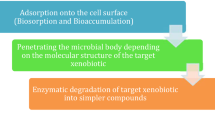Abstract
The ability of strains of the genusRhodococcus to transform chlorinated phenolic compounds was studied. Noninduced cells of several strains ofRhodococcus, covering at least eight species, were found to attack mono-, di-, and trichlorophenols by hydroxylation at theortho position to chlorocatechols. 3-chlorophenol and 4-chlorophenol were converted to 4-chlorocatechol, 2,3-dichlorophenol to 3,4-dichlorocatechol, and 3,4-di-chlorophenol to 4,5-dichlorocatechol. The chlorocatechols accumulated to nearly stoichiometric amounts. Other mono- and dichlorophenols were not transformed. The ability of the strains to hydroxylate chlorophenols correlated with the ability to grow on unsubstituted phenol as the sole source of carbon and energy. SeveralRhodococcus strains attacked chlorophenolic compounds by both hydroxylation and O-methylation. 2,3,4-, 2,3,5- and 3,4,5-trichlorophenol were hydroxylated to trichlorocatechol and then sequentially O-methylated to chloroguaiacol and chloroveratrole. Tetrachlo-rohydroquinone was O-methylated sequentially to tetrachloro-4-methoxy-phenol and tetrachloro-1,4-dimethoxybenzene. Several of the active strains had no known history of exposure to any chloroaromatic compound. Rhodococci are widely distributed in soil and sludge and these results suggest that this genus may play an important role in transformation of chlorinated phenolic compounds in the environment.
Similar content being viewed by others
References
Ahling B, Lindskog A (1982) Emissions of chlorinated organic substances from combustion. In: Hutzinger O, Frei RW, Merian E, Pocchiari F (eds) Chlorinated dioxins and related compounds. Impact on the environment. Pergamon Press, Oxford, pp 215–225
Apajalahti JHA, Salkinoja-Salonen MS (1986) Degradation of polychlorinated phenols byRhodococcus chlorophenolicus. Appl Microbiol Biotechnol 25:62–67
Apajalahti JHA, Salkinoja-Salonen MS (1987) Dechlorination and para-hydroxylation of polychlorinated phenols byRhodococcus chlorophenolicus. J Bacteriol 169:675–681
Apajalahti JHA, Salkinoja-Salonen MS (1987) Complete dechlorination of tetrachlorohydroquinone by cell extracts odRhodococcus chlorophenolicus. J Bacteriol 169:5125–5130
Beadle CA, Smith RW (1982) The purification and properties of 2,4-dichlorophenol hydroxylase from a strain ofAcinetobacter species. Eur J Biochem 123:323–332
Bollag J-M, Helling CS, Alexander M (1968) 2,4-D metabolism. Enzymatic hydroxylation of chlorinated phenols. J Agr Food Chem 16:826–828
Claus D, Lack P, Neu B (eds) (1983) German collection of microorganisms. Collection of strains, 3rd ed. Gesellschaft für Biotechnologische Forschung MBH, Braunschweig, German Federal Republic
Engelhardt G, Rast HG, Wallnöfer PR (1979) Cometabolism of phenol and substituted phenols byNocardia spec. DSM 43251. FEMS Microbiol Lett 5:377–383
Goerlitz DF, Troutman DE, Godsy EM, Franks BJ (1985) Migration of wood-preserving chemicals in contaminated groundwater in a sand aquifer at Pensacola, Florida. Environ Sci Technol 19:955–961
Golovlev EL, Eroshina NV (1982) Catabolism of aromatic compounds in “erythropolis”-group rhodococci. Mikrobiologiya 51:407–413
Häggblom M, Apajalahti J, Salkinoja-Salonen M (1986) Metabolism of chloroguaiacols byRhodococcus chlorophenolicus. Appl Microbiol Biotechnol 24:397–404
Häggblom MM, Apajalahti JHA, Salkinoja-Salonen MS (1988) Hydroxylation and dechlorination of chlorinated guaiacols and syringols byRhodococcus chlorophenolicus. Appl Environ Microbiol 54:683–687
Häggblom MM, Apajalahti JHA, Salkinoja-Salonen MS (1988) O-methylation of chlorinated para-hydroquinones byRhodococcus chlorophenolicus. Appl Environ Microbiol 54:1818–1824
Häggblom MM, Nohynek LJ, Salkinoja-Salonen MS (1988) Degradation and O-methylation of polychlorinated phenolic compounds byRhodococcus andMycobacterium strains. Appl Environ Microbiol 54:3043–3052
Häggblom MM, Janke D, Salkinoja-Salonen MS (1989) Hydroxylation and dechlorination of tetrachlorohydroquinone byRhodococcus sp. strain CP-2 cell extracts. Appl Environ Microbiol 55:516–519
Häggblom MM, Janke D, Middeldorp PJM, Salkinoja-Salonen MS (1989) O-methylation of chlorinated phenols in the genusRhodococcus. Arch Microbiol 152:6–9
Ihn W, Janke D. Tresselt D (1989) Critical steps in degradation of chloroaromatics by rhodococci. III. Isolation and identification of accumulating intermediates and dead-end products. J Basic Microbiol 29:291–297
Janke D, Fritsche W (1985) Nature and significance of microbial cometabolism of xenobiotics. J Basic Microbiol 25:603–619
Janke D, Al-Mofarji T, Schukat B (1988) Critical steps in degradation of chloroaromatics by rhodococci. II. Whole-cell turnover of different monochloroaromatic non-growth substrates byRhodococcus sp. An 117 and An 213 in the absence/presence of glucose. J Basic Microbiol 28:519–528
Janke D, Ihn W, Tresselt D (1989) Critical steps in degradation of chloroaromatics by rhodococci. IV. Detailed kinetics of substrate removal and product formation by resting preadapted cells. J Basic Microbiol 29:305–314
Kitunen V, Valo R, Salkinoja-Salonen MS (1987) Contamination of soil around wood-preserving facilities by polychlorinated aromatic compounds. Environ Sci Technol 21:96–101
Knackmuss H-J, Hellwig M (1978) Utilization and cooxidation of chlorinated phenols byPseudomonas sp. B13. Arch Microbiol 117:1–7
Knuutinen J, Autio P, Klein P, Kivelä S, Virkki L, Lahtiperä M (1988) Synthesis and structure verification of chlorinated 4-methoxyphenols, models of metabolites of chlorophenolic compounds. Chemosphere 17:1821–1829
Kringstad KP, Lindström K (1984) Spent liquors from pulp bleaching. Environ Sci Technol 18:236A-248A
Liu T, Chapman PJ (1984) Purification and properties of a plasmid-encoded 2,4-dichloro-phenol hydroxylase. FEBS Letters 173:314–318
Neilson AH, Allard A-S, Hynning P-Å, Remberger M, Landner L (1983) Bacterial methylation of chlorinated phenols and guaiacols: Formation of veratroles from guaiacols and high-molecular-weight chlorinated lignin. Appl Environ Microbiol 45:774–783
Peczynska-Czoch W, Mordarski M (1983) Transformation of xenobiotics. In: Goodfellow M, Mordarski M, Williams ST (eds) The biology of the actinomycetes. Academic Press, London, pp 287–336
Pfeifer S, Manns O (1957) Photometrische Bestimmung einiger Arnzneimittel mit 4-Aminoantipyrin. Pharmazie 12:401–408
Rast HG, Engelhardt G, Wallnöfer PR (1980) Degradation of aromatic compounds in the actinomycete-genusRhodococcus. FEMS Microbiol Lett 7:1–6
Somani SM, Smart T, Khalique A (1984) Metabolism of 2,4-dichlorophenol by isolated perfused rat liver. J Toxicol Environ Health 13:787–798
Spain J, Gibson DT (1988) Oxidation of substituted phenols byPseudomonas putida F1 andPseudomonas sp. strain JS6. Appl Environ Microbiol 54:1399–1404
Spokes JR, Walker N (1974) Chlorophenol and chlorobenzoic acid co-metabolism by different genera of soil bacteria. Arch Microbiol 96:125–134
Suzuki T (1983) Methylation and hydroxylation of pentachlorophenol byMycobacterium sp. isolated from soil. J Pestic Sci 8:419–428
Valo R, Kitunen V, Salkinoja-Salonen M, Räisänen S (1984) Chlorinated phenols as contaminants of soil and water in the vicinity of two Finnish sawmills. Chemosphere 13:835–844
Vogel AI (1956) A textbook of practical organic chemistry including qualitative organic analysis, 3rd ed. Longman, London
Author information
Authors and Affiliations
Rights and permissions
About this article
Cite this article
Häggblom, M.M., Janke, D. & Salkinoja-Salonen, M.S. Transformation of chlorinated phenolic compounds in the genusRhodococcus . Microb Ecol 18, 147–159 (1989). https://doi.org/10.1007/BF02030123
Issue Date:
DOI: https://doi.org/10.1007/BF02030123




